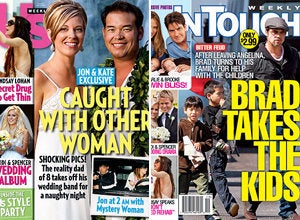
Crisis! Drama! Shocker! These are all words that you would find on the cover of any celebrity weekly.
But, sadly, they all adequately describe the current state of the celebrity weekly category.
While many insiders would point to the recession for the decline in readership, as well as distribution problems and forced price hikes, those are all excuses and lame ones at best.
In fact, these types of magazines should be thriving as most escapist forms of entertainment, like going to the movies, do during tough economic times.
That begs the question what is wrong with the celebrity weekly category?
There are three big reasons why the category is in a crisis and the celebrity weekly bubble has burst.
Reason 1: Too many staffers doing one job function
Walk into any major celebrity weekly and you'll see a staff of 50 or more individuals working in separate departments, including editors, writers, photo editors, creatives and PR executives.
That's the first problem. You have all these individuals doing separate jobs. To survive and prosper creatively, it's time for celebrity weekly magazines to either train their existing staff or hire new staff who can "multi-task."
Instead of having separate departments, magazines should have staffers who can handle all the functions of the magazine - from writing, editing to selecting photos and designing the page - for both the magazine and the Web site. And, yes, the new editors of the future will also handle promoting their content.
Not only will you see an improved editorial product, you'll see a major reduction in fixed costs.
Reason 2: Ignoring the success of celebrity blogs!
Celebrity weeklies are really good at ripping off each other when it comes to layouts and features. But, for some reason, they have felt less compelled to study and imitate the success of blogs.
Most blogs that cover celebrities have succeeded because they have a strong point-of-view. Why don't we see more of that in the celebrity weekly magazines?
It would be nice to see a magazine present the typical voice of a blogger throughout its pages. Or, you can assign various writers to head up individual blog sections that present a point-of-view that stays consistent on a week-to-week basis.
I must point out that a snarky voice is not the way to go. While it has worked for some sites, that tone is not the future. A positive and upbeat approach combined with the writer's "supportive" opinion of the celebrity is a formula for keeping readers coming back to these publications.
Why? The readers love the stars they're reading about and consistently reject content that takes down their idols.
Reason 3: Too much text!
Magazines like In Touch and Us Magazine reinvented the category by introducing a much heavier focus on photos within the pages of their magazines. This approach distinguished In Touch and Us from category leader People Magazine. Readers clearly enjoyed this approach because sales skyrocketed.
The problem? The number of photos used by In Touch and Us Magazine are not enough in 2009. In fact, even those magazines are too text-heavy.
My recommendation to any one of the celebrity weeklies, which includes In Touch, Us, Star, Life & Style and OK!, is to become as photo-driven as humanly possible.
I would go as far as 90 percent photos with 10 percent text.
The text would be used for the big cover story and the captions to accompany the photos throughout the magazine.
Drop any thought of a consistent format. Let the photos of the week tell the story.
A hyper photo-driven magazine could take one of the also ran celebrity weeklies into a new stratosphere when it comes to sales on the newsstand.
Plus, it would clearly differentiate it from the rest of the category, which is a key to success in attracting new readers as well as advertisers.
Most importantly, it would make these magazines a value-add experience to what readers are finding online 24/7.
Bottom Line:
Those that continue to operate like it's 1999 instead of 2009 will eventually be closing their magazines down - blaming everybody but themselves!
The savvy publisher that follows my advice stands to benefit on many fronts. They will have smaller staffs creating more vibrant visual experiences for the readers and ultimately securing more newsstand/subscription readers as well as advertisers.
While some may see this approach as risky, I believe it's a big opportunity to reinvigorate the category. Now, which magazine will go for it?
